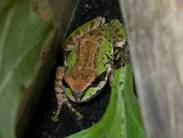Why invasive alien species are a problem
Introduction

According to the World Conservation Union, invasive alien species are the second most significant threat to biodiversity, after habitat loss. In their new ecosystems, invasive alien species become predators, competitors, parasites, hybridizers, and diseases of our native and domesticated plants and animals.
It takes the right conditions for an alien species to become established and grow. In fact, most introduced species do not become permanently established in their newly found environment. They either find the wrong type of conditions for survival, or there they are unable to produce enough offspring to maintain a viable population. For those species that are able to reproduce and survive, most never cause significant problems. They survive, spread and reproduce but generally do not pose a risk to Canada’s economy, environment or society.
Some introduced species however, are able to thrive and even flourish at their new location. They have the right biological properties that allow then to grow in numbers quickly. In addition, they are usually able to reproduce and spread quickly, often out-competing native plant and animal species for food water and space.
Invasive alien species generally share common characteristics which can make them difficult to control and contain, including:
- Higher rates of reproduction - it has been estimated that one Purple Loosestrife plant can produce 3 million seeds.
- Fewer natural predators - newly introduced species are often free of predation and disease, two major factors that keep native plant and animal populations in balance.
- Ability to thrive in different environments - most invasive alien species are generalists, meaning they can survive in a variety of different habitat types and climate regions.
The impact of invasive alien species on native ecosystems, habitats and species is severe and often irreversible, and can cost billions of dollars each year.
Invasive alien species impacts
Environmental impacts

- Can negatively impact biodiversity
- Can cause species extirpation and even extinction
- Can cause soil degradation, and erosion
- Can alter fire cycles
Societal impacts
- Can cause disease
- Can cause human or animal suffering
- Can reduce land and water recreational opportunities
Economic impacts
- Control and management costs can be significant
- Can reduce productivity in forestry, agricultural, and fishing sectors
- Can cause export and import trade restrictions
- Can reduce property values
The following are just some examples of invasive alien species impacts in Canada and abroad. Check regularly as this list will be continuously updated.
Canadian impacts
| Species | Type of impact (economic, environmental, societal) | Description of impact |
|---|---|---|
Zebra Mussel Dreissena polymorpha |
Environmental | Zebra muscles will infest almost every hard surface including rocks, boat hulls, and water intake pipes. They can even grow on the shells of our native clam species, reducing their ability to feed and as such increase mortality. |
Japanese Knotweeds Fallopia japonica & Polygonum cuspidatum |
Environmental | Japanese Knotweed is a perennial shrub from Asia, often considered one of the most persistent of all weeds. Once established in disturbed areas or along stream banks, this highly invasive species can displace virtually all other types of vegetation. |
West Nile Virus Family: Flaviviridae |
Social | The West Nile Virus originated in Africa and Europe. Since its discovery in North America, public health agencies have been waging an aggressive campaign to inform the public about the risks associated with contracting this disease. |
Emerald Ash Borer Agrilus planipennis |
Economic | The cost of eradication and control efforts associated with this invasive insect have totalled in the millions per year. |
Global impacts
| Species | Type of impact (economic, environmental, societal) | Description of impact |
|---|---|---|
Comb Jellyfish Mnemiopsis leidyi |
Economic | This small jellyfish, native to estuaries of eastern North and South America, was almost certainly exported to the Black Sea in ship ballast water. Since it was first discovered in 1992, it has single-handedly caused the collapse of the entire anchovy fishery, an industry once worth millions of dollars per year. |
Brown Tree Snake Boiga irregularis |
Environmental | This invasive alien species first introduced to Guam shortly after World War II, has caused immeasurable damage to the Island's ecosystem. The Brown Tree Snake has been directly linked to the extirpation of several native species of birds (8), lizards (3), and mammals (2 bats). |
Water Hyacinth Agrilus planipennis |
Social | Originally from the Amazon basin, this water plant has spread to many aquatic ecosystems around the world. Whole communities around Lake Victoria, Africa’s largest lake, have had to move to gain better access to open water and fish stocks. |